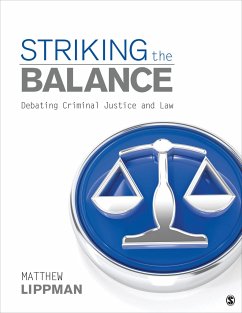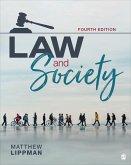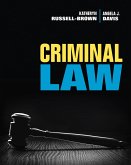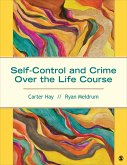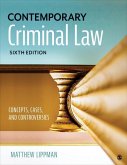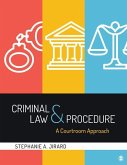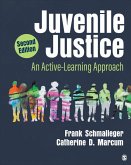- Broschiertes Buch
- Merkliste
- Auf die Merkliste
- Bewerten Bewerten
- Teilen
- Produkt teilen
- Produkterinnerung
- Produkterinnerung
Organizing the book around clashing points of view on contemporary issues in criminal justice and criminal law, award-winning professor and author Matthew Lippman puts each debate into context for students to help them develop their critical thinking skills.
Andere Kunden interessierten sich auch für
![Law and Society Law and Society]() Matthew LippmanLaw and Society199,99 €
Matthew LippmanLaw and Society199,99 €![Criminal Law Criminal Law]() Katheryn K RussellCriminal Law178,99 €
Katheryn K RussellCriminal Law178,99 €![Self-Control and Crime Over the Life Course Self-Control and Crime Over the Life Course]() Carter H HaySelf-Control and Crime Over the Life Course113,99 €
Carter H HaySelf-Control and Crime Over the Life Course113,99 €![The Sage Guide to Writing in Criminal Justice Research Methods The Sage Guide to Writing in Criminal Justice Research Methods]() Jennifer M AllenThe Sage Guide to Writing in Criminal Justice Research Methods51,99 €
Jennifer M AllenThe Sage Guide to Writing in Criminal Justice Research Methods51,99 €![Contemporary Criminal Law Contemporary Criminal Law]() Matthew LippmanContemporary Criminal Law214,99 €
Matthew LippmanContemporary Criminal Law214,99 €![Criminal Law and Procedure Criminal Law and Procedure]() Stephanie A JirardCriminal Law and Procedure236,99 €
Stephanie A JirardCriminal Law and Procedure236,99 €![Juvenile Justice Juvenile Justice]() Frank A SchmallegerJuvenile Justice170,99 €
Frank A SchmallegerJuvenile Justice170,99 €-
-
-
Organizing the book around clashing points of view on contemporary issues in criminal justice and criminal law, award-winning professor and author Matthew Lippman puts each debate into context for students to help them develop their critical thinking skills.
Hinweis: Dieser Artikel kann nur an eine deutsche Lieferadresse ausgeliefert werden.
Hinweis: Dieser Artikel kann nur an eine deutsche Lieferadresse ausgeliefert werden.
Produktdetails
- Produktdetails
- Verlag: Sage Publications
- Seitenzahl: 304
- Erscheinungstermin: 25. Januar 2017
- Englisch
- Abmessung: 279mm x 236mm x 18mm
- Gewicht: 703g
- ISBN-13: 9781506357478
- ISBN-10: 1506357474
- Artikelnr.: 45377888
- Herstellerkennzeichnung
- Libri GmbH
- Europaallee 1
- 36244 Bad Hersfeld
- gpsr@libri.de
- Verlag: Sage Publications
- Seitenzahl: 304
- Erscheinungstermin: 25. Januar 2017
- Englisch
- Abmessung: 279mm x 236mm x 18mm
- Gewicht: 703g
- ISBN-13: 9781506357478
- ISBN-10: 1506357474
- Artikelnr.: 45377888
- Herstellerkennzeichnung
- Libri GmbH
- Europaallee 1
- 36244 Bad Hersfeld
- gpsr@libri.de
Matthew Lippman is Professor Emeritus in the Department of Criminology, Law, and Justice at the University of Illinois Chicago (UIC) and has taught criminal law and criminal procedure for more than 30 years. He has also taught courses on civil liberties, law and society, and terrorism and has taught international criminal law at UIC School of Law. He earned a doctorate in political science from Northwestern University, earned a master of laws from Harvard Law School, and is a member of the Pennsylvania Bar. He has been voted by the graduating seniors at UIC to receive the Silver Circle Award for outstanding teaching on six separate occasions and has also received the UIC Flame Award from the University of Illinois Alumni Association, as well as the Excellence in Teaching Award, the Teaching Recognition (Portfolio) Award, the HOPE Award, and the Honors College Fellow of the Year Award. The university chapter of Alpha Phi Sigma, the criminal justice honors society, named him Criminal Justice Professor of the Year on three occasions. In 2008, he was recognized as a College of Liberal Arts and Sciences Master Teacher. He was honored by the College of Liberal Arts and Sciences, which named him Commencement Marshal at the May 2012 graduation. Professor Lippman is also recognized in Who's Who Among America's Teachers. Professor Lippman is author of 100 articles and author or coauthor of six books. These publications focus on criminal law and criminal procedure, international human rights, and comparative law. He also is author of five other SAGE volumes: Criminal Procedure (4th ed., 2020), Essential Criminal Law (3rd ed., 2020), Law and Society (3rd ed., 2021), Criminal Evidence (2016), and Striking the Balance: Debating Criminal Justice and Law (2018). In 2018, he received the Cornerstone Author Award from SAGE Publishing. His work is cited in hundreds of academic publications and by domestic and international courts and organizations. He also has served on legal teams appearing before the International Court of Justice in The Hague and submitting briefs to the U.S. Supreme Court, has testified as an expert witness on international law before numerous state and federal courts, and has consulted with both private organizations and branches of the U.S. government. Professor Lippman regularly appears as a radio and television commentator and is frequently quoted in leading newspapers. He has served in every major administrative position at UIC in the Department of Criminology, Law, and Justice including Department Head, Director of Undergraduate Studies, and Director of Graduate Studies.
PART 1. Introduction
PART 2. Criminal and Regulatory Laws
2.1 Constitutional Restrictions: Assault Rifles
2.2 Constitutional Restrictions: Hate Crimes
2.3 Criminal Defenses: Stand Your Ground Laws
2.4 Criminal Defenses: Battered Spouse Syndrome
2.5 Criminal Defenses: The Fleeing Felon Rule
2.6 Criminal Defenses: Entrapment
2.7 Crimes Against the Person: Assisted Suicide
2.8 Crimes Against the Person: Felony Murder
2.9 Crimes Against the Person: The Gay Panic Defense
2.10 Crimes Against the Person: Chemical Battery
2.11 Crimes Against Public Order and Morality: Prostitution
PART 3. The Administration of Justice
3.1 Guilty Pleas: Plea Bargaining
3.2 Juries: Peremptory Challenges
3.3 Juries: Nullification
3.4 Evidence: Rap Music
3.5 Sentencing: Mandatory Minimum Sentences
PART 4. Prison, Punishment, and the Eighth Amendment
4.1 Prison: Solitary Confinement
4.2 Punishment: Life Imprisonment for Juvenile Homicide Offenders
4.3 Capital Punishment: The Death Penalty
4.4 Capital Punishment: The Death Penalty for the Rape of a Child
4.5 Capital Punishment: Lethal Injection
Responses to the "You Decide" Features
PART 2. Criminal and Regulatory Laws
2.1 Constitutional Restrictions: Assault Rifles
2.2 Constitutional Restrictions: Hate Crimes
2.3 Criminal Defenses: Stand Your Ground Laws
2.4 Criminal Defenses: Battered Spouse Syndrome
2.5 Criminal Defenses: The Fleeing Felon Rule
2.6 Criminal Defenses: Entrapment
2.7 Crimes Against the Person: Assisted Suicide
2.8 Crimes Against the Person: Felony Murder
2.9 Crimes Against the Person: The Gay Panic Defense
2.10 Crimes Against the Person: Chemical Battery
2.11 Crimes Against Public Order and Morality: Prostitution
PART 3. The Administration of Justice
3.1 Guilty Pleas: Plea Bargaining
3.2 Juries: Peremptory Challenges
3.3 Juries: Nullification
3.4 Evidence: Rap Music
3.5 Sentencing: Mandatory Minimum Sentences
PART 4. Prison, Punishment, and the Eighth Amendment
4.1 Prison: Solitary Confinement
4.2 Punishment: Life Imprisonment for Juvenile Homicide Offenders
4.3 Capital Punishment: The Death Penalty
4.4 Capital Punishment: The Death Penalty for the Rape of a Child
4.5 Capital Punishment: Lethal Injection
Responses to the "You Decide" Features
PART 1. Introduction
PART 2. Criminal and Regulatory Laws
2.1 Constitutional Restrictions: Assault Rifles
2.2 Constitutional Restrictions: Hate Crimes
2.3 Criminal Defenses: Stand Your Ground Laws
2.4 Criminal Defenses: Battered Spouse Syndrome
2.5 Criminal Defenses: The Fleeing Felon Rule
2.6 Criminal Defenses: Entrapment
2.7 Crimes Against the Person: Assisted Suicide
2.8 Crimes Against the Person: Felony Murder
2.9 Crimes Against the Person: The Gay Panic Defense
2.10 Crimes Against the Person: Chemical Battery
2.11 Crimes Against Public Order and Morality: Prostitution
PART 3. The Administration of Justice
3.1 Guilty Pleas: Plea Bargaining
3.2 Juries: Peremptory Challenges
3.3 Juries: Nullification
3.4 Evidence: Rap Music
3.5 Sentencing: Mandatory Minimum Sentences
PART 4. Prison, Punishment, and the Eighth Amendment
4.1 Prison: Solitary Confinement
4.2 Punishment: Life Imprisonment for Juvenile Homicide Offenders
4.3 Capital Punishment: The Death Penalty
4.4 Capital Punishment: The Death Penalty for the Rape of a Child
4.5 Capital Punishment: Lethal Injection
Responses to the "You Decide" Features
PART 2. Criminal and Regulatory Laws
2.1 Constitutional Restrictions: Assault Rifles
2.2 Constitutional Restrictions: Hate Crimes
2.3 Criminal Defenses: Stand Your Ground Laws
2.4 Criminal Defenses: Battered Spouse Syndrome
2.5 Criminal Defenses: The Fleeing Felon Rule
2.6 Criminal Defenses: Entrapment
2.7 Crimes Against the Person: Assisted Suicide
2.8 Crimes Against the Person: Felony Murder
2.9 Crimes Against the Person: The Gay Panic Defense
2.10 Crimes Against the Person: Chemical Battery
2.11 Crimes Against Public Order and Morality: Prostitution
PART 3. The Administration of Justice
3.1 Guilty Pleas: Plea Bargaining
3.2 Juries: Peremptory Challenges
3.3 Juries: Nullification
3.4 Evidence: Rap Music
3.5 Sentencing: Mandatory Minimum Sentences
PART 4. Prison, Punishment, and the Eighth Amendment
4.1 Prison: Solitary Confinement
4.2 Punishment: Life Imprisonment for Juvenile Homicide Offenders
4.3 Capital Punishment: The Death Penalty
4.4 Capital Punishment: The Death Penalty for the Rape of a Child
4.5 Capital Punishment: Lethal Injection
Responses to the "You Decide" Features

